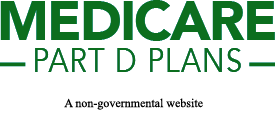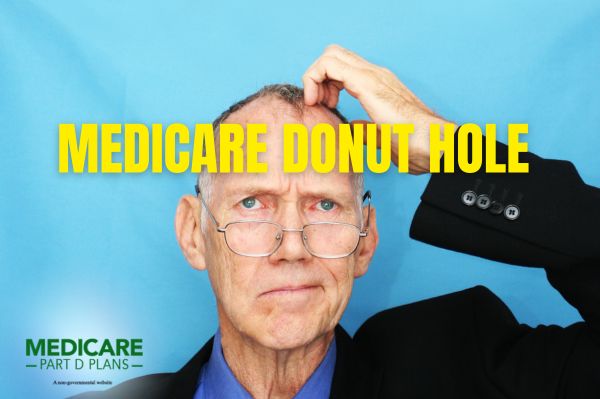Find a Medicare Part D prescription drug plan

Medicare Part D
Prescription Drug Coverage 2026
Donut Hole in Medicare Part D
The ‘donut hole’ in Medicare Part D is a coverage gap that could potentially increase your out-of-pocket costs for prescription drugs. It’s the phase where, after reaching a certain spending limit, you might end up paying more for your medications.
This article will explain what the donut hole is, how it could affect your drug costs, and strategies to help manage these expenses effectively.
Key Takeaways
- The Medicare Donut Hole is a coverage gap in Medicare Part D where beneficiaries might face higher out-of-pocket costs for prescriptions but may be eliminated.
- Strategies such as switching to generic drugs, ordering medications online, and utilizing state pharmaceutical assistance programs could help beneficiaries manage costs during the donut hole.
- The Inflation Reduction Act of 2022 might introduce reforms in Medicare Part D, which may include negotiated drug prices and deductible limits, likely aimed at reducing financial burdens for beneficiaries.
What is the Medicare Donut Hole?
The Medicare Donut Hole is a term that refers to a coverage gap in Medicare Part D where beneficiaries might find themselves paying more out of pocket for their prescription drugs. Medicare Part D drug coverage consists of three stages: the initial coverage phase, the coverage gap (or donut hole), and catastrophic coverage. This gap might be confusing and financially burdensome, especially for those on fixed incomes.
During the initial coverage stage, Medicare beneficiaries will likely pay a portion of their prescription drug costs, typically in the form of copayments or coinsurance, until they reach a certain amount in drug spending.
Once this threshold has been met, beneficiaries enter the donut hole, where out-of-pocket costs may increase significantly. Understanding these stages and the associated costs will likely be crucial for budgeting and managing healthcare expenses effectively.
How Does the Donut Hole Affect Prescription Drug Costs?
The Donut Hole could significantly impact certain prescription drug costs for Medicare beneficiaries. The Donut Hole might include:
- Individuals enter the donut hole when their combined drug costs reach approximately $5,030.
- During this phase, they may be required to pay up to 25% of their medication costs.
- Entering the donut hole might mean paying up to 100% of drug costs until reaching the catastrophic coverage threshold.
- Changes over recent years may have helped to reduce this financial burden.
Starting in 2025, the donut hole may be eliminated, and individuals will likely transition directly to catastrophic coverage after spending about $2,000 on out-of-pocket drug costs. During the catastrophic coverage phase, beneficiaries might not pay out-of-pocket costs for covered prescription drugs.
Likely driven by the Inflation Reduction Act of 2022, these potential changes may be part of broader efforts to lower drug costs and improve affordability for Medicare beneficiaries.
Strategies to Manage Costs in the Donut Hole
Navigating the donut hole could be financially challenging, but several strategies might help manage these costs. Possible ways to reduce out-of-pocket spending might include switch plans to generic drugs, ordering medications online, and utilizing state pharmaceutical assistance programs. However, some individuals may still need to pay out of pocket for certain medications.
Switching to Generic Drugs
One potential strategy for managing prescription drug costs in the donut hole might be switching to generic drugs. Generic medications are chemically identical to their brand-name counterparts but will likely come at a fraction of the cost. These covered drugs may provide equivalent effectiveness, possibly making them a cost-effective alternative to brand-name drugs.
Consulting with your healthcare provider about generic drug options could lead to significant savings on medication expenses. Opting for generics could potentially reduce total drug costs, helping to manage out-of-pocket spending during the coverage gap.
Ordering Medications Online
Ordering medications online might be another strategy that could lead to substantial savings. Possible factors to consider might include:
- Online pharmacies may offer competitive prices.
- The convenience of home delivery could potentially be a significant advantage.
- Members should verify the credibility of the online pharmacy to ensure the safety and efficacy of the medications.
Purchasing medications through legitimate online pharmacies could potentially lead to significant savings on prescription medications costs. This option may be particularly beneficial for those managing multiple prescriptions, as it could simplify the process and possibly reduce overall expenses.
Utilizing State Pharmaceutical Assistance Programs
State pharmaceutical assistance programs may provide financial assistance that could help reduce prescription drug costs during the coverage gap. These programs may vary by state, likely offering different levels of assistance and eligibility requirements to support individuals managing high medication costs through a prescription drug plan, including Medicaid.
Pharmaceutical companies may also offer assistance programs that could help patients manage medication expenses, especially during high-cost periods like the donut hole. Together, these assistance programs could potentially alleviate the financial burden on beneficiaries struggling with paid medication costs during the donut hole period.
Assistance Programs for Extra Help
Managing costs in the donut hole might include exploring financial assistance options to help limit the financial strain. Various programs will likely be designed to offer extra help to beneficiaries, possibly making it easier to handle the financial strain of prescription drug costs.
Medicare Extra Help
The Medicare Extra Help program is a federal initiative that could provide financial assistance for those struggling with prescription costs during the coverage gap.
Eligibility for the Extra Help program will likely be based on an individual’s supplemental security income and resources, and applications may be submitted anytime. To be eligible, applicants must meet specific income and resource limits, which might change yearly.
Those eligible for Extra Help could potentially receive assistance with monthly premium premiums, deductibles, and copayments for their Part D drug plan.
This program could significantly reduce the financial burden on Medicare beneficiaries, possibly ensuring they have access to necessary medications without overwhelming out-of-pocket costs. Additionally, those eligible for Extra Help may benefit from a D plan that could further support their healthcare needs.
Pharmaceutical Assistance Programs
Pharmaceutical companies will likely offer assistance programs that could help individuals afford medications during the donut hole period. These programs may provide discounts, free medications, or help with copayment costs for eligible individuals.
Some patient assistance programs might require applicants to provide proof of income and may also require that the medications be prescribed by a healthcare provider.
These pharmaceutical assistance programs could be a vital resource for those struggling with high prescription drug costs, possibly ensuring that patients do not have to choose between their medications and other essential expenses.
See plans in your area instantly!
Advertisement
The Role of Catastrophic Coverage
Once beneficiaries exit the donut hole, they enter the catastrophic coverage phase, which may significantly lower their out-of-pocket expenses for prescription drugs.
This phase might include:
- Beneficiaries reach catastrophic coverage after their total drug costs surpass a specific threshold, which may vary each year.
- During this phase, Medicare will likely pay most of the costs.
- Beneficiaries may be left with only a small copayment or coinsurance for their medications.
The enrollee might not pay cost sharing for covered Part D drugs, and sponsors typically pay up to 60% of the costs of all covered Part D drugs under the part d plan.
This dramatic reduction in out-of-pocket costs during the catastrophic phase could provide significant relief for beneficiaries facing high medication expenses.
Potential Changes and Future Outlook
Possible changes to Medicare Part D and future outlooks might bring hope for lower prescription drug costs and better affordability for beneficiaries. The Inflation Reduction Act of 2022 may introduce various reforms, which may include the elimination of the donut hole and the negotiation of drug prices.
CY 2026 Part D Redesign
Starting
Additionally, the out-of-pocket threshold for beneficiaries may be set at $2,100, likely reflecting an adjustment from previous years to account for inflation.
These changes may be part of the broader efforts to improve the Medicare program, possibly ensuring it remains sustainable and beneficial for its enrollees.
Potential Impact of Negotiated Prices
Starting
- Part D sponsors may receive a government subsidy for selected drugs equal to about 10% of the drug’s negotiated price.
- This subsidy may also apply to eligible beneficiaries.
These potential changes could potentially lead to lower out-of-pocket costs for beneficiaries and may increase accessibility to necessary covered medications. The overall impact of these negotiated prices will likely be the benefits of a more affordable and sustainable Medicare program.
Find a Plan and Enroll Online Yourself!
Advertisement
Summary
Navigating the Medicare Donut Hole might be challenging, but understanding the coverage phases, managing costs, and exploring available assistance programs could make a significant difference. From switching to generic drugs and ordering medications online to utilizing state pharmaceutical assistance programs, there will likely be several strategies to help manage these out-of-pocket expenses.
Possible changes and future outlooks, including the potential elimination of the donut hole and the possible introduction of negotiated prices, could bring hope for more affordable prescription drug costs. By staying informed and proactive, Medicare beneficiaries may navigate the complexities of Medicare Part D with confidence and ease.
Frequently Asked Questions
What is the Medicare Donut Hole?
The Medicare Donut Hole is a coverage gap in Medicare Part D that may result in beneficiaries incurring higher out-of-pocket costs for prescription medications. It’s essential to understand this aspect to help manage your medication expenses effectively.
How might the Donut Hole affect prescription drug costs?
The Donut Hole may increase prescription drug costs for individuals once their combined drug expenses exceed about $5,030, as they may then be required to pay up to 25% of their medication costs during this phase. This change could significantly impact out-of-pocket expenses for those on regular medications.
What is the Medicare Prescription Payment Plan?
The Medicare Prescription Payment Plan will likely be designed to assist beneficiaries in managing their prescription drug expenses effectively. It could offer a structured payment option for those enrolled in Medicare.
What assistance is available for individuals struggling with prescription costs?
Individuals struggling with prescription costs may access federal programs like Medicare Extra Help, which could offer financial assistance to alleviate expenses during the coverage gap. This support could potentially ease the burden of prescription medications.
What changes might be expected for Medicare Part D?
Medicare Part D might see new deductible limits, out-of-pocket thresholds, and the potential introduction of negotiated prices for certain drugs. These potential changes will likely aim to enhance affordability and accessibility for beneficiaries.
Begin Choosing your plan
Advertisement
ZRN Health & Financial Services, LLC, a Texas limited liability company.


